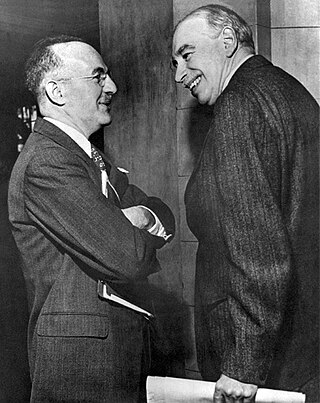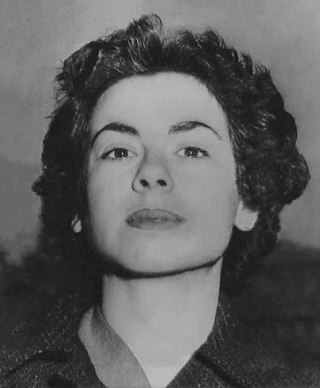
Louise BranstenBerman (October 9, 1908-August 1977) was a member of the Communist Party and a suspected Soviet spy.

Louise BranstenBerman (October 9, 1908-August 1977) was a member of the Communist Party and a suspected Soviet spy.
Louise Rosenberg was born in Berkeley, the daughter of Abraham Rosenberg and Alice Greenbaum. [1] She inherited a fortune from her family's dried fruit importing business, which operated in sixty-five countries. [2] The family's business had previously been sold to a grocery chain for twenty million dollars. [3] She served on the board of The Rosenberg Foundation, a charity established by her family in 1937. [4]
In 1929 she married Richard Bransten, heir to the MJB Coffee fortune. [5] Their son Thomas was born in 1931 and later became a journalist for Ramparts and Fortune . [6] She became the lover of Soviet vice-consul Grigory Markovich Kheifets. J. Robert Oppenheimer met Kheifetz at a cocktail party hosted by Bransten. [7] Kheifets attempted to recruit Oppenheimer for Soviet espionage using Bransten's social connections with George Eltenton. [8] Her other friends involved in Communist Party activities included Nathan Silvermaster and Isaac Folkoff. [9]
In 1942, Bransten arranged a "Salute to Our Russian Ally" event at the San Francisco Opera House that was shut down by the mayor after protests by the American Legion. [10] Bransten worked with Bartley Crum to reverse the mayor's decision, later writing that the controversy showed "how strong the Fascist elements here are" [11]
She was the subject of intense surveillance by the FBI which described her pro-Communist activities as ranging from "mere membership in the Communist Party...to military and industrial espionage and political and propaganda activities". [12] Bransten was referred to in the Venona files by the code name "Map" and described as "a secret member of the CPUSA, a millionaire's daughter, doesn't work anywhere". [13]
Her second husband was Communist Party activist Lionel Berman (1906-1968). [14] He was in charge of the Cultural Section of the Communist Party. [15] Louise Berman and her husband were close friends of Vito Marcantonio, and she was a financial supporter of his campaigns with the American Labor Party. [16]
In 1948 she was questioned in front of the House Un-American Activities Committee about her links to Soviet espionage but refused to answer any questions on the grounds of the Fifth Amendment. [17] She testified again in front of the Committee in 1949 and stated that she had "never engaged in any espionage activity". [18] She defended her financial backing of left-wing causes to the press, stating "if I had $50,000,000 to offer for the perpetuation of racial segregation, some members of this committee might regard me quite favorably". [19] Due to her refusal to cooperate with the Committee, she was held in contempt of Congress. [20] She was acquitted of this charge in 1951. [21] She continued to be involved in politics through the 1960s, helping to raise funds for the Delano Grape strikers in 1963. [22]
Berman's papers are held at the University of Wisconsin-Madison. [23]
The Venona project was a United States counterintelligence program initiated during World War II by the United States Army's Signal Intelligence Service and later absorbed by the National Security Agency (NSA), that ran from February 1, 1943, until October 1, 1980. It was intended to decrypt messages transmitted by the intelligence agencies of the Soviet Union. Initiated when the Soviet Union was an ally of the US, the program continued during the Cold War, when the Soviet Union was considered an enemy.
A Red Scare is a form of moral panic provoked by fear of the rise, supposed or real, of leftist ideologies in a society, especially communism. Historically, "red scares" have led to mass political persecution, scapegoating, and the ousting of those in government positions who have had connections with left-wing to far-left ideology. The name is derived from the red flag, a common symbol of communism.

Julius Rosenberg and Ethel Rosenberg were an American married couple who were convicted of spying for the Soviet Union, including providing top-secret information about American radar, sonar, jet propulsion engines, and nuclear weapon designs. Convicted of espionage in 1951, they were executed by the federal government of the United States in 1953 at Sing Sing in Ossining, New York, becoming the first American civilians to be executed for such charges and the first to be executed during peacetime. Other convicted co-conspirators were sentenced to prison, including Ethel's brother, David Greenglass, Harry Gold, and Morton Sobell. Klaus Fuchs, a German scientist working at Los Alamos Laboratory, was convicted in the United Kingdom.

Harry Dexter White was a senior U.S. Treasury department official. Working closely with the Secretary of the Treasury Henry Morgenthau Jr., he helped set American financial policy toward the Allies of World War II. He was later accused of espionage by passing information to the Soviet Union, an allegation which was confirmed after his death.

Jack Soble was a Lithuanian who, together with his brother Robert Soblen, penetrated Leon Trotsky's entourage for Soviet intelligence in the 1920s. Later, in the United States, he was jailed, with his wife Myra, on espionage charges. He was born in Vilkaviskis, Lithuania as Abromas Sobolevicius and sometimes used the name Abraham Sobolevicius or Adolph Senin.

Judith Coplon Socolov was a spy for the Soviet Union whose trials, convictions, and successful constitutional appeals had a profound influence on espionage prosecutions during the Cold War.
Charles Kramer, originally Charles Krevisky was a 20th-Century American economist who worked for U.S. President Franklin D. Roosevelt as part of his brain trust. Among other contributions, he wrote the original idea for the Point Four Program. He also worked for several congressional committees and hired Lyndon B. Johnson for his first Federal job. Kramer was alleged a Soviet spy as member of the Ware Group, but no charges were brought against him.

Elizabeth Terrill Bentley was an American NKVD spymaster, who was recruited from within the Communist Party USA (CPUSA). She served the Soviet Union as the primary handler of multiple highly placed moles within both the United States Federal Government and the Office of Strategic Services from 1938 to 1945. She defected by contacting the Federal Bureau of Investigation (FBI) and debriefing about her espionage activities.
Philip Olin Keeney (1891–1962), and his wife, Mary Jane Keeney, were librarians who became part of the Silvermaster spy ring in the 1940s.
Lt. Col. Duncan Chaplin Lee (1913–1988) was a confidential senior assistant to Maj. Gen. William Donovan, founder and director of the Office of Strategic Services (OSS), World War II-era predecessor of the CIA, between 1942 and 1946. Lee has posthumously been identified by the Venona project as the NKVD mole inside the OSS with the code name "Koch", making Lee the most senior alleged spy the Soviet Union ever recruited inside the U.S. intelligence community.
As early as the 1920s, the Soviet Union, through its GRU, OGPU, NKVD, and KGB intelligence agencies, used Russian and foreign-born nationals, as well as Communists of American origin, to perform espionage activities in the United States, forming various spy rings. Particularly during the 1940s, some of these espionage networks had contact with various U.S. government agencies. These Soviet espionage networks illegally transmitted confidential information to Moscow, such as information on the development of the atomic bomb. Soviet spies also participated in propaganda and disinformation operations, known as active measures, and attempted to sabotage diplomatic relationships between the U.S. and its allies.
John Jacob Abt was an American lawyer and politician, who spent most of his career as chief counsel to the Communist Party USA (CPUSA) and was a member of the Communist Party and the Soviet spy network "Ware Group" as alleged by Whittaker Chambers.
Alfred Epaminondas Sarant, also known as Filipp Georgievich Staros and Philip Georgievich Staros, was an engineer and a member of the Communist party in New York City in 1944. He was part of the Rosenberg spy ring that reported to Soviet intelligence. Sarant worked on secret military radar at the United States Army Signal Corps laboratories at Fort Monmouth, New Jersey. Alexandre Feklisov, one of the KGB case officers who handled the Rosenberg spy apparatus described Sarant and Joel Barr as among the most productive members of the group. Sarant was recruited as a Soviet espionage agent by Barr.
Clarence Francis Hiskey (1912–1998), born Clarence Szczechowski, was a scientist who worked on the Manhattan Project and was identified as Soviet espionage agent. He became active in the Communist Party USA (CPUSA) when he attended graduate school at the University of Wisconsin.

Atomic spies or atom spies were people in the United States, the United Kingdom, and Canada who are known to have illicitly given information about nuclear weapons production or design to the Soviet Union during World War II and the early Cold War. Exactly what was given, and whether everyone on the list gave it, are still matters of some scholarly dispute. In some cases, some of the arrested suspects or government witnesses had given strong testimonies or confessions which they recanted later or said were fabricated. Their work constitutes the most publicly well-known and well-documented case of nuclear espionage in the history of nuclear weapons. At the same time, numerous nuclear scientists wanted to share the information with the world scientific community, but this proposal was firmly quashed by the United States government.
Grigory Markovich Kheifets, also known as Grigori Kheifetz (1899–1981), was a Soviet intelligence officer, a lieutenant colonel of the NKVD-MGB. He was one of the principals in Soviet nuclear espionage. From December 1941 until July 1944, he was the San Francisco Soviet intelligence station chief or Rezident.
Allan Robert Rosenberg was a 20th-century American labor lawyer and civil servant, accused as a Soviet spy by Elizabeth Bentley and listed under Party name "Roy, code names "Roza" in the VENONA Papers and code name "Sid" in the Vasilliev Papers; he also defended Dr. Benjamin Spock.
Richard Bransten was an American novelist, screenwriter, and Communist Party member.